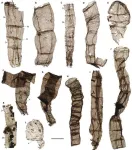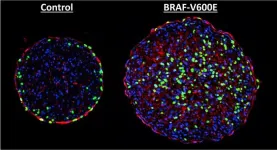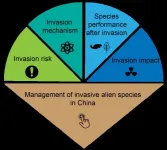(Press-News.org) Mass Eye and Ear physician-researchers show that retinal imaging can help predict a person’s risk of developing ocular, neuropsychiatric, cardiac, metabolic, and pulmonary diseases.
The team also identified genetic loci associated with retinal thinning, which could help develop personalized treatment plans and future therapies for eye diseases such as glaucoma and macular degeneration.
The retina is said to provide a window into a person’s systemic health. In a new study published January 24th in Science Translational Medicine, physician-researchers from Mass Eye and Ear, a member of Mass General Brigham, and the Broad Institute of MIT and Harvard combined retinal imaging, genetics and big data to estimate how likely a person is to develop eye and systemic diseases in the future. They found significant associations between the thinning of different retinal layers and increased risk of developing ocular, neuropsychiatric, cardiac, metabolic, and pulmonary diseases and identified genes that are associated with retinal layer thickness.
“We showed that retinal images could be used to predict the future risk of both ocular disease and systemic disease,” says first author Seyedeh Maryam Zekavat, MD,PhD, a Harvard Ophthalmology resident at Mass Eye and Ear and graduate student at Broad. “This could potentially help with disease prevention—if we know from someone’s retinal image that they are at high risk of developing glaucoma or cardiovascular disease in the future, we could refer them for follow-up screening or preventative treatment.”
Because of its position behind the transparent structures of the eye, the retina is easy to visualize and image non-invasively, and retinal imaging is already a routine procedure in ophthalmology. The new study uncovers possibilities for preventative medicine and crosstalk between ophthalmologists and other areas of medicine.
Previous studies have shown that there are links between retinal health and health conditions including aging, cardiometabolic diseases such as diabetes and hypertension, and neurological diseases such as dementia, stroke, and multiple sclerosis.
“We’ve come to realize recently that there is a lot more information that we can get from our retina images than we thought was possible,” says senior author Nazlee Zebardast, MD, MSc, director of Glaucoma Imaging at Mass Eye and Ear and an assistant professor of ophthalmology at Harvard Medical School. “It's really exciting to be able to see that these images, which are obtained without having to do any sort of invasive procedure, are associated with so many systemic conditions, both at a genetic level as well as an epidemiologic level.”
To identify associations between retinal health and disease risk, and to identify genes associated with retinal health, the researchers analyzed data from 44,823 UK Biobank participants who underwent optical coherence tomography (OCT) imaging of the retina, genotyping, and baseline measurements of health in 2010 and were then followed for disease development for an average of ten years.
Unlike previous studies that searched for genes associated with overall retina health, this study delved deeper into the role of the different cell layers that make up the retina.
“Each layer of the retina is made up of different types of cells with diverse structures and functions, and we show that the thicknesses of these different layers are associated with different conditions,” says Zebardast, who is also an associated scientist at Broad.
The study also provides insight into the genes and biological pathways that determine retinal health, which could be leveraged to develop future therapies, the researchers say. Altogether, the team identified 259 genetic loci that were associated with retinal thickness.
One particular insight from this work was that multiple systemic health conditions including poor cardiac, metabolic, pulmonary, and renal function are linked to thinning of the photoreceptor segment of the retina, though further research would be needed to confirm causality. Future studies should also aim to replicate the study’s methods in more diverse populations and different age groups, since participants in the UK BioBank were predominantly white and aged 40-70 years old at baseline.
The study is part of an ongoing effort at Mass Eye and Ear to identify genetic markers of glaucoma and other ocular diseases that might help to develop personalized risk scores and treatment plans for patients. Retinal OCT imaging is already a standard clinical procedure in ophthalmology at Mass Eye and Ear and elsewhere, but the authors say that their results suggest that its use could be widened. Further work on the connection between ocular and cardiometabolic health will enable understanding of its clinical utility, and the researchers are extending this line of research along with co-author Pradeep Natarajan, MD, director of preventive cardiology at Massachusetts General Hospital, and an associate member in the Cardiovascular Disease Initiative at Broad.
“Patients come to us for their eye health, but what if we could tell them more than that?” says Zebardast. “What if we could use someone's retinal images to tell them, ‘You seem to have a high risk of having high blood pressure, maybe you should get screened, or maybe your primary care doctor should know about that.’”
The authors have developed an online user-interface for all of their findings on the Ocular Knowledge Portal, to enable researchers to explore associations between retinal layer thickness, disease and genetics.
Authorship: Seyedeh Maryam Zekavat (MEE, MGH, Broad) Saman Doroodgar Jorshery (Broad) Franziska G. Rauscher (Lepzig), Katrin Horn (Leipzig), Sayuri Sekimitsu (Tufts) Satoshi Koyama (MGH, Broad) Trang T. Nguyen (Broad) Maria C. Costanzo (Broad), Dongkeun Jang (Broad), Noël P. Burtt (Broad), Andreas Kühnapfel (Leipzig) Yusrah Shweikh (MEE), Yixuan Ye (Yale), Vineet Raghu (MGH, Broad), Hongyu Zhao (Yale), Marzyeh Ghassemi (Toronto), Tobias Elze (MEE), Ayellet V. Segrè (MEE) , Janey L. Wiggs (MEE), Lucian Del Priore (Yale), Markus Scholz (Leipzig), Jay C. Wang (Yale) Pradeep Natarajan (MGH, Broad) Nazlee Zebardast (MEE, Broad).
Disclosures: Natarajan reports research grants from Allelica, Apple, Amgen, Boston Scientific, Genentech / Roche, and Novartis; personal fees from Allelica, Apple, AstraZeneca, Blackstone Life Sciences, Creative Education Concepts, CRISPR Therapeutics, Eli Lilly & Co, Foresite Labs, Genentech / Roche, GV, HeartFlow, Magnet Biomedicine, Merck, and Novartis; scientific advisory board membership of Esperion Therapeutics, Preciseli, and TenSixteen Bio; scientific cofounder of TenSixteen Bio; equity in MyOme, Preciseli, and TenSixteen Bio; and spousal employment at Vertex Pharmaceuticals, all unrelated to the present work. Wiggs has received grant support from Aerpio and served as a consultant for Allergan, Avellino, Editas, Maze, and Regenxbio outside of the present work, has served as a consultant for Zeiss. No conflicting relationship exists for other authors.
Funding: This study was supported by the National Eye Institute with additional support from the Hassenfeld Scholar Award from the Massachusetts General Hospital, grants from the National Heart, Lung, and Blood Institute and analysis support from the LIFE Leipzig Research Center for Civilization Diseases. A full list of funders can be found in the paper.
Paper cited: Zekavat, SM et al. “Phenome- and genome-wide analyses of retinal optical coherence tomography images identify links between ocular and systemic health” Science Translational Medicine DOI: 10.1126/scitranslmed.adg4517
###
About Mass Eye and Ear
Massachusetts Eye and Ear, founded in 1824, is an international center for treatment and research and a teaching hospital of Harvard Medical School. A member of Mass General Brigham, Mass Eye and Ear specializes in ophthalmology (eye care) and otolaryngology–head and neck surgery (ear, nose and throat care). Mass Eye and Ear clinicians provide care ranging from the routine to the very complex. Also home to the world's largest community of hearing and vision researchers, Mass Eye and Ear scientists are driven by a mission to discover the basic biology underlying conditions affecting the eyes, ears, nose, throat, head and neck and to develop new treatments and cures. In the 2023–2024 “Best Hospitals Survey,” U.S. News & World Report ranked Mass Eye and Ear #4 in the nation for eye care and #7 for ear, nose and throat care. For more information about life-changing care and research at Mass Eye and Ear, visit our blog, Focus, and follow us on Instagram, Twitter and Facebook.
END
Retinal imaging and genetics data used to predict future disease risk
2024-01-24
ELSE PRESS RELEASES FROM THIS DATE:
North China fossils show eukaryotes first acquired multicellularity 1.63 billion years ago
2024-01-24
In a study published in Science Advances on Jan. 24, researchers led by Prof. ZHU Maoyan from the Nanjing Institute of Geology and Palaeontology of the Chinese Academy of Sciences reported their recent discovery of 1.63-billion-year-old multicellular fossils from North China.
These exquisitely preserved microfossils are currently considered the oldest record of multicellular eukaryotes. This study is another breakthrough after the researchers’ earlier discovery of decimeter-sized eukaryotic fossils in the Yanshan area ...
Harnessing skin cancer genes to heal hearts
2024-01-24
DURHAM, N.C. – Biomedical engineers at Duke University have demonstrated that one of the most dangerous mutations found in skin cancers might moonlight as a pathway to mending a broken heart.
The genetic mutation in the protein BRAF, a part of the MAPK signaling pathway that can promote cell division, is one of the most common and most aggressive found in melanoma patients. In a new study, researchers show that introducing this mutation to rat heart tissue grown in a laboratory can induce growth.
Repairing ...
Special Feature calls attention to biological invasion research in China
2024-01-24
This month, the Ecological Society of America spotlights the challenge posed by invasive alien species in China with the release of a Special Feature, “Management of Biological Invasions in China,” in the latest issue of its journal Ecological Applications.
Accelerating rates of biological invasion have led to growing concerns about the destructive impacts of invasive alien species, or IAS, on the environment and human societies. This is especially true in China, which has witnessed a surge in ...
Researchers add a ‘twist’ to classical material design
2024-01-24
Researchers with the Department of Energy’s SLAC National Accelerator Laboratory, Stanford University and the DOE's Lawrence Berkeley National Laboratory (LBNL) grew a twisted multilayer crystal structure for the first time and measured the structure’s key properties. The twisted structure could help researchers develop next-generation materials for solar cells, quantum computers, lasers and other devices.
“This structure is something that we have not seen before – it was a huge surprise to me,” said Yi Cui, a professor at Stanford and SLAC and paper co-author. “A new quantum electronic property could appear ...
The costly, unintended consequences produced by the National Flood Insurance Program
2024-01-24
Since the creation of the National Flood Insurance Program (NFIP) in 1968, the U.S. government has paid over $51 billion to cover flood losses. Almost half of these payouts went to just 25 counties, among the fastest-growing counties by population. A new paper published in the Journal of the Association of Environmental and Resource Economists examines whether insuring people against potential flood losses contributes directly to population growth in flood-prone areas. In “Does the National Flood Insurance Program Drive Migration ...
Tiny vibrating bubbles could lead to better water treatment
2024-01-24
Fresh research into the physics of vibrating nanobubbles reveals that they do not heat up as much as previously thought.
Vibrating nanobubbles have surprising uses as ultrasound contrast agents in cancer diagnosis. They can also be forced to collapse - destroying nearby microscopic contaminants - for waste-water treatment and surface cleaning of delicate microfluidic devices.
The stiffness of a nanobubble as it vibrates is strongly related to their internal temperature, and being able to understand ...
Self-powered movable seawall for tsunami protection and emergency power generation
2024-01-24
With over 2,780 fishing ports and 993 commercial and industrial ports, Japan faces the challenge of safeguarding these important coastal assets from the destructive forces of tsunamis. A promising solution lies in the form of a movable barrier system, where gates rising from the seafloor act as barriers, protecting ports against tsunamis, storm surges and high waves. However, during natural disasters, power outages may disrupt the electricity needed to operate the gate.
To address this, researchers led by Professor Hiroshi Takagi from Tokyo Institute of Technology have proposed ...
Groundwater levels are sinking ever faster around the world
2024-01-24
At the beginning of November, The New York Times ran the headline, “America is using up its groundwater like there’s no tomorrow.” The journalists from the renowned media outlet had published an investigation into the state of groundwater reserves in the United States. They came to the conclusion that the United States is pumping out too much groundwater.
But the US isn’t an isolated case. “The rest of the world is also squandering groundwater like there’s no tomorrow,” says Hansjörg Seybold, Senior Scientist in the Department of Environmental Systems Science at ETH Zurich. He is coauthor ...
$1.2 million grant awarded to LSU LCMC Health Cancer Center to help break down barriers to cervical cancer prevention
2024-01-24
NEW ORLEANS (Jan. 24, 2024) – A research team from LSU LCMC Health Cancer Center has been awarded a $1.5 million grant to eliminate barriers from cervical cancer prevention. The five-year program combines a $1.2 million award from the American Cancer Society and $75,000 a year for five years investment from LSU Health New Orleans.
Louisiana has one of the highest cervical cancer death rates in the country. Cervical cancer rates are higher in predominantly African American communities represented in both urban (New Orleans) and rural areas of Louisiana. Black women in Louisiana are diagnosed with and die from cervical cancer at a significantly ...
Off-road autonomy: U-M's Automotive Research Center funded with $100 million through 2028
2024-01-24
Images
The U.S. Army has extended its long-running relationship with the University of Michigan's Automotive Research Center, reaching a new five-year, agreement of up to $100 million to boost work on autonomous vehicle technologies.
This potentially doubles the federal government's financial investment with ARC since the last agreement, reached in 2019. Following its 1994 launch, the ARC has served as a source of technology and first-in-class modeling and simulation for the Army's fleet of vehicles—the largest such fleet in the world.
"We are driving the development of modern mobility systems with our advanced modeling ...






